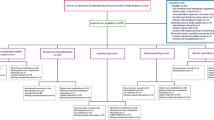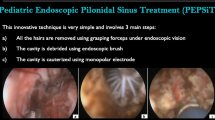Abstract
Pilonidal sinus disease is associated with a high rate of recurrence and complications. The Karydakis (KAR) method, whereby an asymmetric subcutaneous flap obliterates the anal crease, has been shown to be effective in adults. The goal of this study is to assess the efficacy of the KAR procedure in the operative treatment of children with pilonidal sinus disease compared to those treated via a midline excision (ME). Sixty-eight cases of pediatric pilonidal sinus excision were reviewed over the past 10 years. Data abstracted included surgical approach, complication rate and recurrence rate. Student’s t-test or the Chi square test was used for statistical analysis, with P<0.05 being considered significant. An ME was performed in 44 patients; the KAR method was used in 24 patients. Mean age at diagnosis was 14.4±4.2 years for the ME group compared to 15.7±4.3 years for the KAR patients (P=0.18). Mean operative time was significantly longer with the KAR method (58.7±25.6 min) compared to 46.3±18.6 for the primary ME (P=0.04). Despite the increased operative dissection, there was no difference (P=0.42) in early post-operative complication rates between groups (25% in the KAR group compared to 34.8% in the ME group). Initial drainage of an abscess had no significant effect upon the recurrence/complication rate in either group. Recurrence rate alone was lower in patients operated on via the KAR approach 0% versus 11.0% using the ME (P=0.153). Recurrence and complication rates were lower for those patients with a pilonidal sinus treated by the KAR method compared to the ME, but the results did not reach significance. In conclusion, this study does show a potential benefit for children treated with the KAR method for pilonidal sinus. This study mimics the data obtained in adult patients and suggests that a larger study is likely to achieve significance.

Similar content being viewed by others

References
Hodges RM (1880) Pilonidal sinus. Boston Med Surg J 103:485–486
Corman ML (1999) Cutaneous condition. In: Cormon ML (ed) Colon and rectal surgery, 3rd edn. Lippincott, Philadelphia, pp 374–435
Patey DH, Scarff RW (1990) Pathology of postanal pilonidal sinus, its bearing on treatment. Br J Surg 77:123–132
Karydakis GE (1992) Easy and successful treatment of pilonidal sinus after explanation of its causative process. Aust N Z J Surg 62:385–389
Aydede H, Erhan Y, Sakarya A, Kumkumoglu Y (2001) Comparison of three methods in surgical treatment of pilonidal disease. Aust N Z J Surg 71:362–364
Petersen S, Kock R, Stelzner S, Wendlandt TP, Ludwig K (2002) Primary closure techniques in chronic pilonidal sinus: a survey of the results of different surgical approaches. Dis Colon Rectum 45:1458–1467
Allen-Mersh TG (1990) Pilonidal sinus: finding the right track for treatment. Brit J Surg 77:123–132
Al-Jaberi TM (2001) Excision and simple primary closure of chronic pilonidal sinus. Eur J Surg 167:133–135
Anyanwu AC, Hossain S, Williams A, Montgomery AC (1998) Karydakis operation for sacrococcygeal pilonidal disease: experience in a district general hospital. Ann R Coll Surg Engl 80:197–199
Kitchen PR (1996) Pilonidal sinus: experience with the Karydakis flap. Brit J Surg 85:874
Schoeller T, Wechselberger G, Otto A, Papp C (1997) Pilonidal sinus: experience with the Karydakis flap. Brit J Surg 84:890–891
Bascom J, Bascom T (2002) Failed pilonidal surgery. Arch Surg 137:1146–1150
Acknowledgments
This study was fully approved by the Institutional Review Board of our Hopsitals.
Author information
Authors and Affiliations
Corresponding author
Rights and permissions
About this article
Cite this article
Morden, P., Drongowski, R.A., Geiger, J.D. et al. Comparison of Karydakis versus midline excision for treatment of pilonidal sinus disease. Ped Surgery Int 21, 793–796 (2005). https://doi.org/10.1007/s00383-005-1543-1
Accepted:
Published:
Issue Date:
DOI: https://doi.org/10.1007/s00383-005-1543-1



